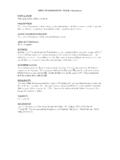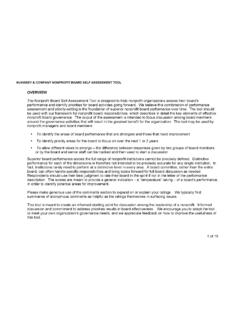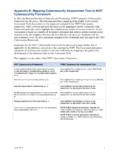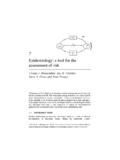Transcription of The Livelihood Assessment Tool-kit
1 The Livelihood Assessment Tool-kit Analysing and responding to the impact of disasters on the livelihoods of people[First Edition]Published by Food and Agriculture Organization of the United Nations (FAO), RomeandInternational Labour Organization (ILO), GenevaApril 2009 First published 2009 The designations employed and the presentation of material in this publication do not imply the expression of any opinion whatsoever on the part of the Food and Agriculture Organization of the United Nations (FAO) or of the International Labour Organization (ILO) concerning the legal or development status of any country, territory, city or area or of its authorities, or concerning the delimitation of its frontiers or boundaries. The mention of specific companies or products of manufacturers, whether or not these have been patented, does not imply that these have been endorsed or recommended by FAO or ILO in preference to others of a similar nature that are not mentioned.
2 The views expressed herein are those of the authors and do not necessarily represent those of FAO or rights reserved. Reproduction and dissemination of material in this information product for educational or other non-commercial purposes are authorized without any prior written permission from the copyright holders provided the source is fully acknowledged. Reproduction of material in this information product for resale or other commercial purposes is prohibited without written permission of the copyright holders. Applications for such permission should be addressed to: Chief, Electronic Publishing Policy and Support Branch, Communication Division, FAO, Viale delle Terme di Caracalla, 00153 Rome, Italy or by email to: FAO and ILO, 2009 ISBN 978-92-5-106230-2iiiTA B L E O F C O N T E N T SAcronyms and Abbreviations.
3 IvPreface ..vVolume 1: Methodological and Conceptual Overview ..1 Volume 2: Livelihood Baseline and Contingency Plan ..17 Volume 3: Initial Livelihood Impact Appraisal ..67 Volume 4: Detailed Livelihood C r O Ny mS A Nd A B Br E v iATi O N SAEZ Agro-ecological ZonesCBO Community-based OrganizationCSO Central Statistics OfficeDLA Detailed Livelihood Assessment DSA Daily Subsistence AllowanceFAO Food and Agriculture Organization of the United NationsFEWSNET Famine Early Warning System NetworkGIS Geographic Information SystemsIDP Internally displaced personIFI International Funding InstitutionsILIA Initial Livelihood Impact AppraisalILO International Labour OrganizationLAT Livelihood Assessment tool -kitLB Livelihood BaselineLFS Labour Force SurveysNGO Non-governmental organizationOCHA Office for the Coordination of Humanitarian AffairsPDNA Post-Disaster Needs AssessmentPRA Participatory Rapid Assessment / AppraisalSLF Sustainable livelihoods FrameworkSSI
4 Semi-structured InterviewingTL Team LeaderUN United NationsUNDAC United Nations Disaster Assessment and CoordinationUNDP United Nations Development ProgrammeUNIDO United Nations Industrial Development OrganizationUNOSAT United Nations consortium created to provide enhanced access to satellite imagery and geographic information systemsWFP World Food ProgrammevP r E F A C EIn 2007 a total of 414 natural disasters were reported, spread over some 115 countries, killing 16 847 people, affecting more than 211 million others and causing economic damages amounting to USD 75 billion. This is part of a trend of rising disaster frequency, and in this context, protecting and rebuilding the livelihoods of those vulnerable to disasters becomes an urgent priority. Assessing the impact of disasters on the livelihoods of people and the capacity and opportunities for recovery and increased resilience to future events is an important part of the response to disasters, yet current Assessment systems are often weak, uncoordinated and are not strongly linked to Livelihood recovery interventions.
5 In order to improve understanding of the impact of disasters on livelihoods , the Food and Agriculture Organization of the United Nations (FAO) and the International Labour Organization (ILO) have jointly developed the Livelihood Assessment Tool-kit (LAT). The LAT consists of three main technical elements: Livelihood Baseline Assessment (which is undertaken pre-disaster); Immediate Livelihood Impact Appraisal (undertaken immediately after the disaster); and Detailed Livelihood Assessment (undertaken up to 90 days after the disaster). In the process of development, the LAT has been tested, redefined and refined in a number of countries including Pakistan (2005 Kashmir earthquake); Indonesia (2006 volcanic eruption and earthquake in Yogjakarta); Philippines (2006 Typhoon Reming); Bolivia (2007 flooding); and Pakistan again in 2008 ( Livelihood baseline work).
6 This process of continual learning and improvement continues, and so the current set of guidelines contained in these volumes should be seen as one stage in the development of the approach. In this spirit, suggestions for improvement are welcomed and should be directed to: and Rome and ILO, Geneva April 2009VO LU M E 1 Methodological and Conceptual OverviewThe Livelihood Assessment Tool-kit Analysing and responding to the impact of disasters on the livelihoods of peoplevolume 1: methodological and Conceptual Overview[First Edition]Published by Food and Agriculture Organization of the United Nations (FAO), RomeandInternational Labour Organization (ILO), GenevaM e t h o d o l o g i c a l a n d C o n c e p t u a l O v e r v i e w3M e t h o d o l o g i c a l a n d C o n c e p t u a l O v e r v i e wTA B L E O F CO N T E N T SOverview of the Livelihood Assessment Tool-kit for Sudden Onset Disasters.
7 5 Assessment Preparedness ..8 Sustainable Livelihood Approach and the LAT ..10 Livelihood assets ..11 Vulnerability and coping strategies ..13 The institutional context ..14 Livelihood strategies and outcomes ..15M e t h o d o l o g i c a l a n d C o n c e p t u a l O v e r v i e w5M e t h o d o l o g i c a l a n d C o n c e p t u a l O v e r v i e wOverview of the Livelihood Assessment Tool-kit for Sudden Onset Natural disastersThe Livelihood Assessment Tool-kit (LAT) process consists of three inter-related elements: a Livelihood Baseline (LB); an initial Livelihood impact Appraisal (ILIA); and a detailed Livelihood Assessment (DLA).
8 As currently designed, the LAT is aimed at sudden onset natural disasters. However, it is planned to extend the coverage of the LAT to other types of emergency. Each of the three parts of the LAT serves different but related functions in the Assessment process. Each part may also have different targets in terms of funding mechanisms and may be executed by different people, as indicated in the following table. ElementFunctionProgramming/funding targetWhen and by whom?LB - Livelihood BaselineTo provide a good picture of normal Livelihood patterns in areas at risk from natural hazards together with an indication of likely impact of hazards, key response priorities and institutions likely to be involved in recovery. Gives a head start for post-disaster assessments.
9 Provides the pre-disaster context for the ILIA and DLA, so enhancing the power of these tools to make informed generalizations on the Livelihood impact and opportunities presented by the is useful to elaborate quick briefs for flash appeal, early recovery donor conference and information to the public. Could be used to extrapolate from, if ILIA is not possible before Flash Appeals. When? Time taken to compile baseline: Heavily dependent on size and complexity of hazard prone areas. In Pakistan, district level baselines take 2-3 weeks each. Compilation done before the disaster. By whom? Ideally, multi-agency teams drawn from UN, governments, e t h o d o l o g i c a l a n d C o n c e p t u a l O v e r v i e wM e t h o d o l o g i c a l a n d C o n c e p t u a l O v e r v i e wILIA -Initial Livelihood Impact AppraisalInitial Assessment of impact of disaster on livelihoods at local level to be integrated into multi-sectoral quick impact assessments and feeding into Flash Appeal provides immediate first hand information on the impact of the disaster on the livelihoods of the affected people.
10 This info is to be combined with the baseline, thus giving a solid basis to the proposals for immediate action on Livelihood recovery that will feed the first Flash Appeals, early recovery donor conference and subsequent livelihoods programmes. When? Duration of Assessment : 1 7 days. Usual window for Assessment : Within first 10 days after disaster. By whom? Ideally national government and UN staff /consultants integrated into the United Nations Disaster Assessment and Coordination (UNDAC) team. DLA -Detailed Livelihood AssessmentAssessment of impact of disaster on livelihoods and opportunities, capacities and needs for recovery at household, community, and local economy levels. Includes conversion of the results of assessments into response options containing strategy outlines programme profiles and concrete a more detailed information and rationale for strategies, programmes and projects to be submitted to Revised Flash appeal and / or Early Recovery donor conference, for funding purposes, and / or development of Livelihood Recovery Strategies.

















